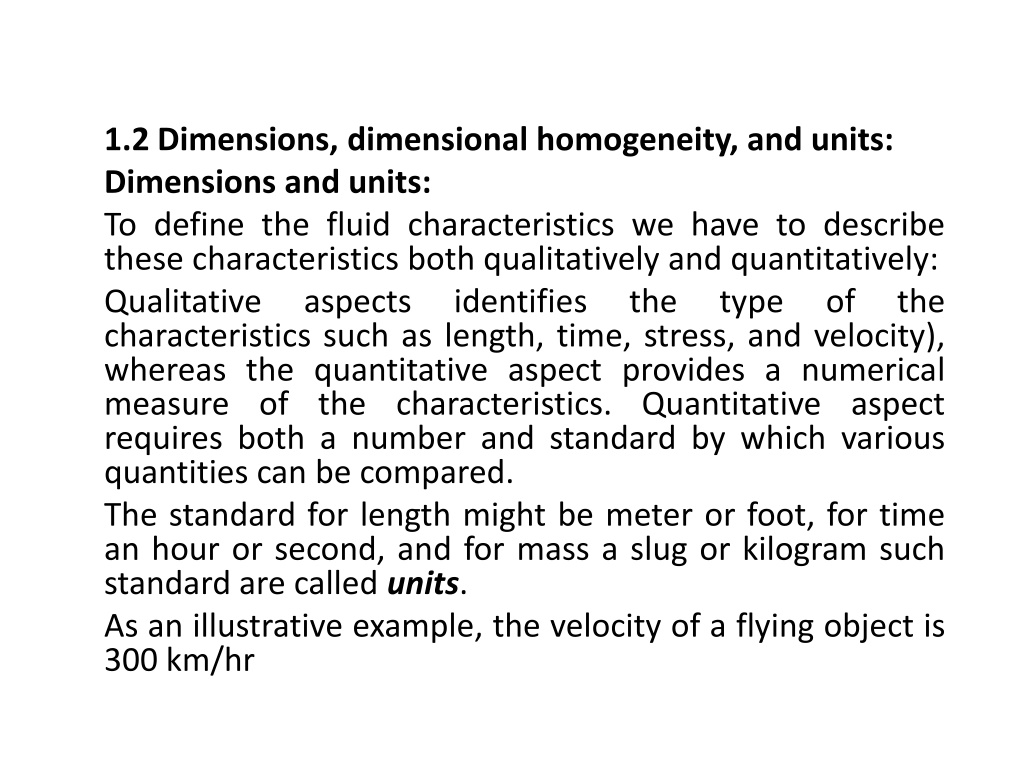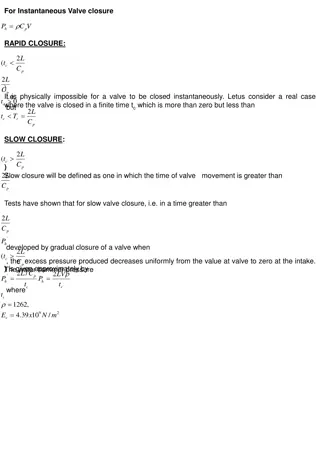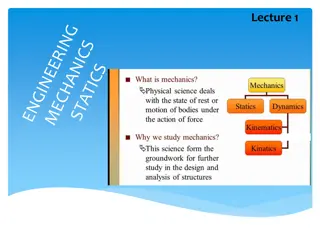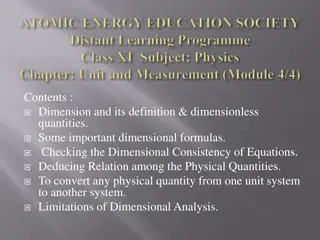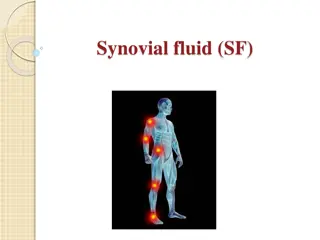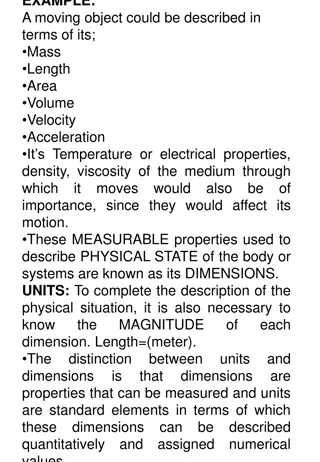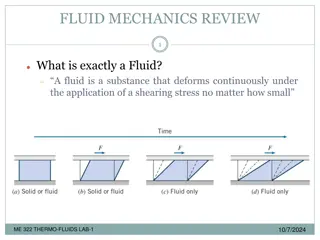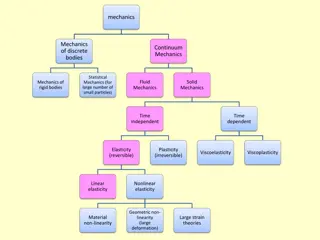Understanding Dimensions, Dimensional Homogeneity, and Units in Fluid Mechanics
Qualitatively and quantitatively defining fluid characteristics involves dimensions and units such as length, time, stress, and velocity. Primary units like Length (L), Time (T), Mass (M), and Temperature provide a basis for describing secondary quantities. Dimensional homogeneity equations play a crucial role, ensuring consistency across different systems of units like the British Gravitational (BG) System and the International System (SI) in fluid mechanics.
Download Presentation

Please find below an Image/Link to download the presentation.
The content on the website is provided AS IS for your information and personal use only. It may not be sold, licensed, or shared on other websites without obtaining consent from the author. Download presentation by click this link. If you encounter any issues during the download, it is possible that the publisher has removed the file from their server.
E N D
Presentation Transcript
1.2 Dimensions, dimensional homogeneity, and units: Dimensions and units: To define the fluid characteristics we have to describe these characteristics both qualitatively and quantitatively: Qualitative aspects identifies characteristics such as length, time, stress, and velocity), whereas the quantitative aspect provides a numerical measure of the characteristics. Quantitative aspect requires both a number and standard by which various quantities can be compared. The standard for length might be meter or foot, for time an hour or second, and for mass a slug or kilogram such standard are called units. As an illustrative example, the velocity of a flying object is 300 km/hr the type of the
Here; the qualitative aspect is the velocity and the quantitative aspect is 300km/hr (300 is the number and km/hr is the standard). The basic or primary units are: Length denoted by (L), Time denoted by (T), Mass denoted by (M), and Temperature denoted by ( ). These primary quantities can be used to provide a qualitative description of any other secondary quantity: for example, Area = ?2 Velocity = ?? 1 Density = ?? 3, and so on. Notice: symbol = is used to indicate the dimensions of the secondary quantities in terms of the primary quantities. As a consequence to describe qualitatively a velocity (V) it should be written as: V inm ? = The above equations could be described as the dimensions of velocity equal (length divided by time). ? ? = ?? 1
For many problems involving fluid mechanics, only the three basic dimensions, L, M, T are required. Alternatively L, F, T could be used where F is the basic dimension of force.
Dimensionally homogeneous equations: If we have an equation represents velocity of a uniformly accelerated body: , Which is general homogeneous equation. Notice: general homogeneous equations are valid in any system of units.
1.2.1 Systems of units: - British Gravitational (BG) System: In this system the unit of length is foot (ft) , the time unit is second (s), the force unit is pound (lb), and the temperature unit is the degree Fahrenheit (oF) or the absolute temperature unit is the degree Rankin (oR), Where, The mass unit called slug is defined from Newton s second law (force=mass*acceleration) as 1 lb = (1 slug)(1 ft/s2) This relation indicates that a 1lb force acting on a mass of 1slug will give it an acceleration of 1ft/s2. The weight W (which is the force due to gravity, g) of mass, m is given by the equation Since the earth s standard gravity is taken as the mass of 1 slug weighs 32.2 lb under standard gravity. - International System (SI): Length, meter (m) Time, second (s) Mass, kilogram (kg) It follows that
Temperature, Kelvin (K) , Force, Newton (N) , g in SI units = 9.81 m/s2 then 1 kg mass weighs 9.81 N under standard gravity. Work, Joule (J) ,1J=1 N.m Power, watt (w), 1W=1 J/s = 1N.m/s -English Engineering (EE) System: Mass, pound mass (lbm) Force, pound force (lb) Length, foot (ft) Time, second (s) Temperature, degree Rankin (oR) For EE, a 1 lb force is defined as that force which gives a 1 lbm a standard acceleration of gravity which is taken as 32.174 ft/s2. Thus for, to be both numerically and dimensionally correct so that, Where, g is the local acceleration of gravity. Under the standard condition of gravity (g=gc). The weight in pounds and the mass in pound mass are
numerically equal. Since 1lb force gives a mass of 1lbm an acceleration of 32.174 ft/s2 and a mass of 1 slug an acceleration of 1 ft/s2 it results in 1 slug = 32.174 lbm The table below gives the conversion factors from SI units to BG and EE units
1.3 Analysis of fluid behavior: The study of fluid mechanics involves: Newton s second law of motion, conservation of mass, and first and second law of thermodynamics. Fluid mechanics can be generally subdivided into fluid statics (where fluid is at rest) and fluid dynamics (where the fluid is in motion), as shown below:
Fluid statics deals with fluids at rest where there is no relative movement between consequence, there is no shear force and all forces due to the pressure of fluid are normal to the surface on which they act. fluid elements. As a Fluid dynamics deals with the fluids at motion, so the shear forces are involved and fluid properties such as density and viscosity has to be considered in the analysis. Hydrostatics treats with the statics of the incompressible fluids such as liquids. Hydrodynamics deals with the dynamic study of incompressible fluid Gasdynamics is the dynamic study of compressible fluids.
1.4 Measure of fluid mass and weight: 1.4.1 density ( ) is defined as the mass per unit volume in SI units in BG units Specific volume ( v) is the volume per unit mass which is the inverse of the density this property is not commonly used in fluid mechanics but is used in thermodynamics. 1.4.2 Specific weight ( ) is defined as the weight per unit volume in SI units = lb/ft3 in BG units
1.4.3 Specific gravity (SG) the ratio of densities Is defined as the ratio of the density of fluid to the density of water at the same specific temperature. Then 1.5 Ideal gas law: Where, P is the absolute pressure (measured relative to absolute zero pressure) Notice: absolute zero pressure = 101 kpa (abs) = 14.7 psi (abs) is the gas density T is the absolute temperature K R is the universal gas constant = 2.869E2 j/kg.k for air Pressure in a fluid at rest is defined as the normal force per unit area exerted on a plane surface immersed in a fluid.
1.6 Viscosity: Fluid viscosity is the property for all real fluids that relates shear stress and fluid motion by means of sustaining frictional resistance to motion. When a fluid subjected to a shear force it deforms continuously (flows). It is found that the shear stress (shear force divided by the surface area and denoted by ) is proportional to the time rate of deformation (strain). That is du dy and expressed the velocity change divided by the distance over which the change occurs.
If we take shearing stress as the rate of shearing strain is increased in a direct proportion, then Where ? is the shear stress ? is the dynamic viscosity (N.s/m2) it is also known as absolute viscosity ?? ?? wall. The above equation is called Newton s law of viscosity. The viscosity of any fluid is caused by the cohesion forces. As the cohesion decreases with increasing fluid temperature, so that the viscosity of liquids decreases with increasing fluid temperature. In contrast with gases the viscosity depends on the transfer of molecules momentum which increases with temperature. Therefore, viscosity of gases increases with increasing gas temperature. is the time rate of deformation (strain) or the velocity gradient to the
Another notation of viscosity is the kinematic viscosity (v ) which is the ratio of dynamic viscosity to density in (m2/s) and its dimension is L2/T. charts of absolute and kinematic viscosity is given in figures B.1 and B.2
